Simplifying inter-building fiber networks
By DR. IAN TIMMINS, Optical Cable Corporation (OCC) -- As the demand for high-bandwidth networks continues to proliferate on campuses of all types, many are struggling with how to implement a high-count fiber backbone that supports high-speed data requirements, and yet is reconfigurable to suit both current and future needs.
For many of these campuses – multi-building complexes such as hospitals, corporate centers, government facilities and universities – future needs are not currently known and incorporating a network system that offers both high-density and easy accessibility is a challenge. Thus, a reliable and reconfigurable system innately suited to increasing bandwidth-hungry users is needed for dynamic support of future applications.
These types of fiber installations are becoming very popular because everyone is certain of two things. Firstly, supporting the typical user means accommodating higher bandwidth demands. Secondly, changes in the network configuration are inevitable. In most current situations these networks will be based on high-count fiber-optic backbone cabling systems. Architectures with fiber counts of 144 and 288 are not uncommon, and installations with even higher numbers are emerging.
Unfortunately, many networks that are composed of high-count fiber-optic cable ultimately experience disappointments and frustrations with the conventional type of cabling and connectivity. High fiber count cables with a large O.D. are inflexible and are hard to manage and install which can risk broken fibers and jeopardize the success of the system. This, combined with connectivity utilizing stacks of splice trays feeding adapter plates with extremely high fiber counts, can make for infrastructure that is very challenging to service or execute moves, adds, and changes.
Conventional implementations intended to enhance versatility and thereby overcome this challenge can easily lead to systems with too many connectors in the communications channel. This causes increased attenuation, decreased bandwidth results and general degradation in signal integrity. Stacks of splice trays that must be manipulated to access a single fiber can disrupt the entire network every time service is performed. Ultimately, conventional network architecture is prone to disruptions, increased financial costs due to maintenance, and premature system overhauls.
A new “blade-like” approach
This is a fiber network solution designed for building-to-building applications, incorporating a unique “blade-like” splicing system along with OCC’s HC-Series cable, a proprietary high-count indoor/outdoor fiber-optic cable. With the new Blade connectivity solution, network managers have a product offering available to them that is "splice-centric."
The OCC Blade Solution in combination with OCC’s HC cable uses an "in-line flow" of individual fiber groups that provides slack storage, splicing, and access to industry standard couplers, all in a form factor that can be easily accessed from either the front or back of the rack-mount chassis and wall-mount enclosures. The real benefit is that fiber subgroups can be accessed independently of all other subgroups, as there is no arbitrary stack of splice trays located behind a wall of adapter plates. The Procyon Blade system provides a single solution for an organized, accessible, high-performance and dense network system.
The Blade system can be coupled with OCC’s distinct HC-Series cable, which has been designed specifically to be a flexible high-density, riser-rated and rugged fiber cable with a very small diameter. It contains tight-buffered fiber units, which consists of 12 fibers being encapsulated by a matrix material and then surrounded by a tightly bound buffer material, which gives it a very rugged characteristic. Each of the 12 tight-buffered fiber units is two millimeters in diameter, providing in total a relatively small cable containing a lot of fibers.
The conception of the HC-Series cable was a high fiber count, small diameter cable, reducing the outer cable diameter by 20 percent or more compared to similar cables. The cable is extremely rugged, with good mechanical (crush and flex) and environmental characteristics. Unlike traditional ribbonized cables, the HC cable has no preferential bend, making it ultra flexible for tight bends and much easier to work with and splice. Each of the 12 tight-buffered fiber units can be easily routed into the Blade enclosures for splicing or can be terminated with MTP or MPO connectors for patching.
The OCC Blade system is a cabling and connectivity solution that directly integrates with existing networks or passive optical LANs. Users patch into the network with jumpers from the switch, directly into this system. This will provide the highest quality channel performance from building-to-building, to fulfill both current and future infrastructure needs.
Dr. Ian Timmins is Vice President of Engineering, Enterprise Connectivity Products at Optical Cable Corporation (OCC). For information contact: Optical Cable Corporation (OCC), 5290 Concourse Drive, Roanoke, Virginia, 24019; Phone: (800) 622-7711, Canada (800) 443-5262; FAX: 540-265-0724; Email: [email protected]; Visit the web site www.occfiber.com.

